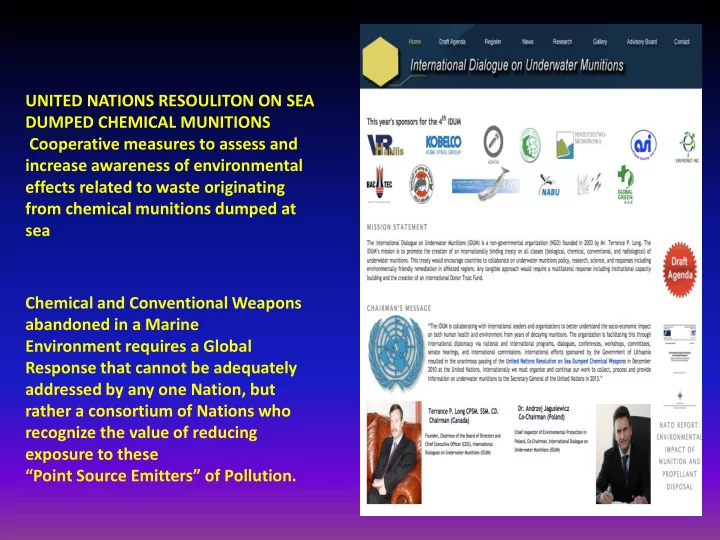

UNITED NATIONS RESOULITON ON SEA DUMPED CHEMICAL MUNITIONS Cooperative measures to assess and increase awareness of environmental effects related to waste originating from chemical munitions dumped at sea Chemical and Conventional Weapons abandoned in a Marine Environment requires a Global Response that cannot be adequately addressed by any one Nation, but rather a consortium of Nations who recognize the value of reducing exposure to these “Point Source Emitters” of Pollution.
International Scientific Advisory Board (ISAB) on Sea Dumped chemical Weapons, The Hague Prof. Stanislaw Witek (Chairman), Wroclaw University of Technology, Wroclaw (Poland) Dr Paul F. Walker, Global Green, Washington DC (USA) (Co-Chair) Dr. Andrzej Jagusiewicz, Chief Inspector of Environment Protection (Poland) Prof. Alexander D. Gorbovskiy, Scientific and Technical Center of Special Technologies, Hospital Moscow (Russian Federation) Dr Ralf Trapp, International Consultant, Chemical and Biological Weapons Disarmament (France) Dr. John Hart, SIPRI (Sweden) Dr. Thomas Stock, Dynasafe (Germany) Dr. Robert Mathews, Head, NBC Arms Control, Victoria DoD (Australia) Prof. S.I.Baranovskij, President of the Green Cross Russia, (Russian Federation) Dr. Habil.Janina Baršiene, Nature Research Centre Laboratory of Ecotoxicology, (Lithuania) Dr. Algirdas Stankevičius, Environmental Protection Agency , Department of the Marine Research, (Lithuania) Mr. Finn Longinotto , Washington DC Global Green (USA)
Munitions can be found in major quantities in every ocean in the world. They can be found from a reservoir in Jakarta, Indonesia to the pristine lakes of the Swiss Alps at the foot of the Edger to the Great Lakes of North America. In addition to those dumped at sea, a vast number of munitions have been abandoned in rivers, lakes, reservoirs, and inland water ways. Former inland sites remain largely unrecognized, and are today found near many populated areas. In some cases, they share the same waters used by communities for human consumption and irrigation purposes.
In the years immediately following the end of the war, ships carrying mustard gas left regularly from Sydney and Halifax for local dumpsites; in some instances the entire vessel were scuttled. The closure of US military installations in Newfoundland and Labrador, was a source of widespread munitions dumping. It is reported that off Argentia, large boats left every two days to dump munitions in the Cabot Strait, for a five month period .
Statistics of reported incidents with chemical munitions in the Baltic Sea Area, 1995-2009
Science is an important tool which teaches us how to lead safe and productive lives. But science without logic and wisdom has its limitations. For instance, we may never be able to conclusively determine how much exposure to what particular chemical it takes to diminish a person’s health. Yet reducing critical pathways of exposure to toxic substances is clearly a wise investment, even if the costs seem high in the short term.
According to a US Department of Energy study, some ammunition abandoned in salt water as far back as WWI can be found intact. Furthermore, individual munitions as small as six inches in diameter have been determined to have a toxic footprint measurable up to three meters from the source. It is important to note that this footprint identifies only the presence of explosives, and not some of the far more persistent break down products such as explosive salts
According to information published by Hunt Oil, one of the companies involved in exploration off the coast of Canada, the sound in a radius of five meters from the air guns is at the level of 260 decibels, which is considered lethal. Up to 2,000 meters away, the sound is still at the 190-decibel level, which they consider to have possible physical effects on marine life. November 2004 resolution of the 16 member states of the Agreement for the Conservation of Marine Mammals in the Black Sea, Mediterranean Sea and adjoining Atlantic area, which called for "extreme caution" in conducting activities that produce intense underwater noise. (Crab Study)
Photograph of a DMM being examined by the Nereus HROV at a depth of approximately 800 m during operations off the coast of Hawaii (image courtesy of Andy Bowen, WHOI).
International Technology Advisory Board on Sea Dumped Weapons
Recommend
More recommend